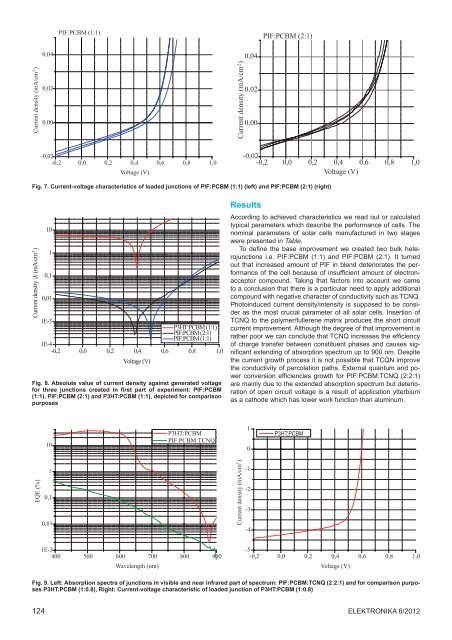Proceedings of the European Summer School of Photovoltaics 4 â 7 ...
Proceedings of the European Summer School of Photovoltaics 4 â 7 ...
Proceedings of the European Summer School of Photovoltaics 4 â 7 ...
You also want an ePaper? Increase the reach of your titles
YUMPU automatically turns print PDFs into web optimized ePapers that Google loves.
PIF:PCBM (1:1)<br />
PIF:PCBM (2:1)<br />
Current density (mA/cm 2 )<br />
0,04<br />
0,02<br />
0,00<br />
Current density (mA/cm 2 )<br />
0,04<br />
0,02<br />
0,00<br />
-0,02<br />
-0,2 0,0 0,2 0,4 0,6 0,8 1,0<br />
Voltage (V)<br />
-0,02<br />
-0,2 0,0 0,2 0,4 0,6 0,8 1,0<br />
Voltage (V)<br />
Fig. 7. Current-voltage characteristics <strong>of</strong> loaded junctions <strong>of</strong> PIF:PCBM (1:1) (left) and PIF:PCBM (2:1) (right)<br />
Current density |J| (mA/cm 2 )<br />
10<br />
1<br />
0,1<br />
0,01<br />
1E-3<br />
P3HT:PCBM (1:1)<br />
PIF:PCBM (2:1)<br />
PIF:PCBM (1:1)<br />
1E-4<br />
-0,2 0,0 0,2 0,4 0,6 0,8 1,0<br />
Voltage (V)<br />
Fig. 8. Absolute value <strong>of</strong> current density against generated voltage<br />
for three junctions created in first part <strong>of</strong> experiment: PIF:PCBM<br />
(1:1), PIF:PCBM (2:1) and P3HT:PCBM (1:1), depicted for comparison<br />
purposes<br />
Results<br />
According to achieved characteristics we read out or calculated<br />
typical parameters which describe <strong>the</strong> performance <strong>of</strong> cells. The<br />
nominal parameters <strong>of</strong> solar cells manufactured in two stages<br />
were presented in Table.<br />
To define <strong>the</strong> base improvement we created two bulk heterojunctions<br />
i.e. PIF:PCBM (1:1) and PIF:PCBM (2:1). It turned<br />
out that increased amount <strong>of</strong> PIF in blend deteriorates <strong>the</strong> performance<br />
<strong>of</strong> <strong>the</strong> cell because <strong>of</strong> insufficient amount <strong>of</strong> electronacceptor<br />
compound. Taking that factors into account we came<br />
to a conclusion that <strong>the</strong>re is a particular need to apply additional<br />
compound with negative character <strong>of</strong> conductivity such as TCNQ.<br />
Photoinduced current density/intensity is supposed to be consider<br />
as <strong>the</strong> most crucial parameter <strong>of</strong> all solar cells. Insertion <strong>of</strong><br />
TCNQ to <strong>the</strong> polymer/fullerene matrix produces <strong>the</strong> short circuit<br />
current improvement. Although <strong>the</strong> degree <strong>of</strong> that improvement is<br />
ra<strong>the</strong>r poor we can conclude that TCNQ increases <strong>the</strong> efficiency<br />
<strong>of</strong> charge transfer between constituent phases and causes significant<br />
extending <strong>of</strong> absorption spectrum up to 900 nm. Despite<br />
<strong>the</strong> current growth process it is not possible that TCQN improve<br />
<strong>the</strong> conductivity <strong>of</strong> percolation paths. External quantum and power<br />
conversion efficiencies growth for PIF:PCBM:TCNQ (2:2:1)<br />
are mainly due to <strong>the</strong> extended absorption spectrum but deterioration<br />
<strong>of</strong> open circuit voltage is a result <strong>of</strong> application ytterbium<br />
as a cathode which has lower work function than aluminum.<br />
10<br />
P3HT:PCBM<br />
PIF:PCBM:TCNQ<br />
1<br />
0<br />
P3HT:PCBM<br />
EQE (%)<br />
1<br />
0,1<br />
0,01<br />
Current density (mA/cm 2 )<br />
-1<br />
-2<br />
-3<br />
-4<br />
1E-3<br />
400 500 600 700 800 900<br />
Wavelength (nm)<br />
-5<br />
-0,2 0,0 0,2 0,4 0,6 0,8 1,0<br />
Voltage (V)<br />
Fig. 9. Left: Absorption spectra <strong>of</strong> junctions in visible and near infrared part <strong>of</strong> spectrum: PIF:PCBM:TCNQ (2:2:1) and for comparison purposes<br />
P3HT:PCBM (1:0.8), Right: Current-voltage characteristic <strong>of</strong> loaded junction <strong>of</strong> P3HT:PCBM (1:0.8)<br />
124<br />
Elektronika 6/2012

















